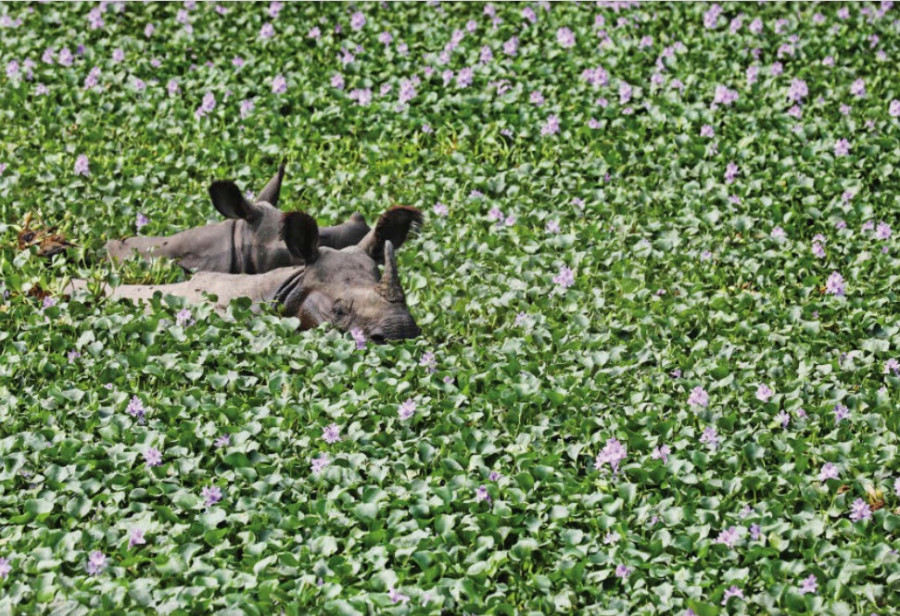Climate & Environment
After delays, authorities gear up to count country’s rhinos this season
Officials at protected areas across the country have moved ahead with the preparations for conducting the census, which is likely to begin in March this year.
Chandan Kumar Mandal
The long shelved-off census of one-horned rhinos in the country's protected areas is finally going to take place this year as the authorities have started preparations for counting the pachyderms.
After several postponements, the periodical counting of one-horned rhinos in Nepal’s national parks is likely to take place in March, if everything goes as planned.
According to Haribhadra Acharya, a spokesperson for the Department of National Park and Wildlife Conservation, the central body responsible for the management of protected areas and wildlife dwelling in those parks, preparations have already started for conducting the rhino census this season.
“The advisory committee formed to conduct rhino census has asked the line agencies to go ahead with the preparations for counting rhinos,” Acharya told the Post. “The exact date is not final yet. But this is the season for counting rhinos.”
The advisory committee, which consists of government officials, wildlife experts and representatives from conservation partners, instructed the park authorities to clear grassland for counting rhinos and make other required arrangements.
According to Acharya, the perfect timing for counting rhinos is when grasslands are clear, giving adequate visibility for counters to see rhinos in the field.
“Timing is perfect when the grassland is open so it can also be in March. Following the committee’s instruction, grassland clearance, which is also happening regularly, has started,” said Acharya.
The outcome of the census will be looked at carefully as there has been a worrying surge in deaths of one-horned rhinos in Chitwan. Although poaching of rhinos has been largely under control, these deaths have been reported due to natural causes.
In the fiscal year 2016-17, 25 rhinos were reported dead, including one killed by poachers. Twenty-six rhinos died in the fiscal year 2017-18, 43 in 2018-19, and 26 in 2019-20. So far this fiscal year, 22 rhinos have died.
“The rhino count is conducted on a specific period to show a trend of population,” said Acharya. “The census result will also help in identifying issues and enforce interventions required for their conservation.”
The upcoming census will also help in determining the concentration of rhinos, mainly in Chitwan National Park, where natural deaths have seen an alarming rise. A team of wildlife experts—part of the team formed to investigate the increasing deaths of one-horned rhinos in Chitwan, suggested an internal relocation of the rhinos as one of the measures for saving the animal.
The team had found that a majority of rhinos were concentrated in the western side of the park, leading to clashes, one of the reasons behind their deaths. Natural deaths of rhinos have come as a major cause of concern among conservationists.
But such a significant census has seen frequent postponements in the last two years.
The last nationwide count held in 2015 had put the country's rhino population at 645—605 in Chitwan National Park, 29 in Bardiya National Park, eight in Shuklaphanta National Park, and three in Parsa National Park.
Then the next periodic count was scheduled for 2019, which did not happen because the government could not manage the funds, pushing the count for 2020.
In March last year, counting was first postponed indefinitely after the government barred gatherings with more than 25 people in one place as part of the measures to contain the spread of coronavirus in the country. Then the counting, which was scheduled for March 23, became uncertain as the country went into a four-month lockdown beginning March 24.
The authorities had to postpone the census till 2021 looking for the perfect timing (February-March).
Although the department has not set a new date, the rhino census, it says, won’t be cancelled this time.
According to Acharya, who is also an ecologist with the department, the logistical arrangement was made last year and now only grassland management is required. After two weeks, a team from the department will visit protected parks, to inspect the progress on grassland management.
Another advisory committee meeting, which is scheduled two weeks later, will make the final decision on dates for beginning the count.
“We have not fixed the exact date because if there is rain then grassland management can be affected once again. Also controlled firing has to be done for clearing grassland,” said Acharya.




 16.12°C Kathmandu
16.12°C Kathmandu











